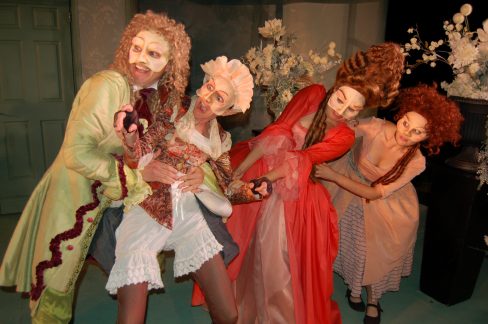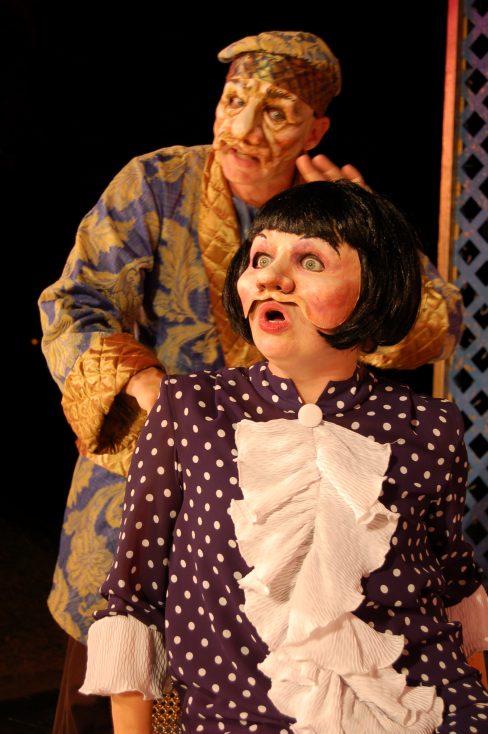by Chris King
Where Did Commedia Dell’Arte Originate?
There is no easy answer to this and it is still the subject of much debate (you’ll find plenty of that on YouTube with a basic search of Commedia dell’Arte). But historians seem to agree on a few possibilities. One is the theatre of Atellan Farce, taken from Roman fables that revolved around crass and ridiculous physical comedy, a prominent feature of Commedia.
The second possibility is that it may have been derived from mime theatre made popular by monks of the Byzantine Era.
Who knew monks did comedy? Well believe it or not, this is where mime comes from. If you’ve seen any Commedia (here is a good Italian sample), you may have noticed that many Commedia characters do not speak at all during performances, instead babbling incoherently to humorous effect.
The final possibility and perhaps the most likely would be Bohemian influences from Europe where performers took to the streets to put on shows. Commedia was frequently performed in public squares in the early years.[1]
i (The) Gelosi – The First Troupe
The first Commedia performances happened around 1551 when “unorganized strolling players, acrobats, street entertainers started to coalesce.” I Gelosi was the first incorporated theatre troupe of its kind that employed professional actors. The company would have paid the performers a salary and charged admission to its shows – a big step forward in helping establish theatre as a true profession. Interestingly, The Gelosi’s coat of arms was the two-faced Roman god Janus, and symbolized the travelling nature of the group, as well as the dual personalities often portrayed by the actors.[2] The Gelosi performed both in Italy and in France, where they received both patronage and protection from the king.
Women in Commedia
One of the first stories of gender equality on the stage happened in the world of Commedia dell’Arte. Unlike other forms of theatre, the female roles in Commedia were actually portrayed by women. These women were respected and valued for their ability to perform and their own individual qualities. However, they were at times badly denigrated by critics, and for a period in Italy, a short-lived effort was made to ban women from the Commedia stage. But by the end of the 16th century their presence was largely accepted.[3]
Early 17th Century – A change in form
By the early 17th century the format of Commedia was changing from strictly improvisational to something much more scripted, with clearly structured acts and characters. Several books written during the 17th century made recommendations about how the plays should be performed. Some critics argued that this change caused the performances to become formulaic and stylized, taking away the improvisational quality that made Commedia so unique.[4]
17th Century – Taking shape
Despite its supposed Italian origins, Commedia dell’Arte wound up being more popular in France (there called The Comédie-Italienne) than Italy throughout the 17th century. In fact, it was in France where it developed its established repertoire. As it moved elsewhere across Europe it continued to evolve and adapt based on the cultural preferences of its adoptive countries. In England, The Punch and Judy puppet shows, still popular today, owe their concept to the Pulcinella mask from the Neapolitan (the city of Napoli) version of the form.
Unfortunately Commedia took a big hit during the 17th century in Great Britain, mostly due to the Puritan influence. The Puritans were not big supporters of the arts of any kind and shows were often banned altogether. Napoleon also played his part in limiting its spread. During his occupation of Italy, proponents of reform and critics of French rule used the carnival masks to hide their identities while pushing political agendas, challenging social rule, and hurling insults and criticisms at the regime.[5] So to put an end to it, Napoleon banned Commedia Dell’Arte completely. His banning was a major blow as Commedia did not resurface again until 1979 in Venice, and much of its original quality has been lost history.
Early 18th Century
By the early 1700s, Commedia troupes had entertained audiences across the continent and had even been “commissioned to play for Europe’s most distinguished monarchs, including Queen Elizabeth, Louis XIV, and Russia’s Empress Anna.”[6] By the end of the 18th and 19th century Commedia players eventually found their way overseas to the new world.[7] Do the names Harlequin, Columbine, Scaramouche, and Pantaloon sound familiar? They are the popular names of clowns now heard frequently today in all types of theatrical performances. Cirque du Soleil comes to mind.
Conclusion
While much of the purest form of Commedia has been lost to the history books, the majority of its influence today is still widely felt in all forms of theatre today. Fortunately with companies like Odyssey Theatre, much of the art is being recaptured and brought back to its former glory. While this year’s production of Lysistrata and the Temple of Gaia is not a Commedia play, you will see clear evidence of Commedia’s influence in the play’s outrageous side-splitting antics.
So here’s to the continued success and history of a truly remarkable art form! Next time you see a clearly recognizable type of acting, be sure to ask yourself how that character came to be. Because there is a good chance it started in Commedia!
[1] Commedia dell’arte. https://www.britannica.com/art/commedia-dellarte (accessed April 21, 2018)
[2] Commedia dell’arte. https://en.wikipedia.org/wiki/Commedia_dell%27arte (accessed April 19, 2018)
[3] A History of Commedia dell’Arte. http://www.factionoffools.org/history (accessed April 21, 2018)
[4] Commedia dell’arte. https://en.wikipedia.org/wiki/Commedia_dell%27arte (accessed April 19, 2018)
[5] Commedia dell’arte. https://en.wikipedia.org/wiki/Commedia_dell%27arte (accessed April 23, 2018)
[6] A History of Commedia dell’Arte. http://www.factionoffools.org/history (accessed April 20, 2018)) http://www.factionoffools.org/history
[7] A History of Commedia dell’Arte. http://www.factionoffools.org/history (accessed April 20, 2018))







